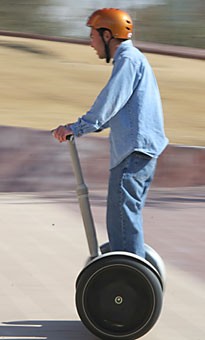Andrew Crandall doesn’t sweat getting from one side of campus to the other. While students lugging backpacks are speed-walking from the Harvill building to Modern Languages, Crandall floats past, riding what looks like a glorified push lawnmower.
He is the proud owner of a Segway Personal Transporter, a two-wheeled, self-balancing transportation device.
Crandall said he usually gets asked two questions when he is approached by people around campus about his Segway: “”How fast does it go?”” from guys and “”How much does it cost?”” from girls.
Crandall, a junior majoring in Spanish, said there were a few important reasons why he purchased his Segway PT in 2004, the main being that he wanted a transportation device that did not pollute.
“”It matters a lot to me because I see all these cars polluting and I don’t want to be a part of that,”” Crandall said.
He also said having a Segway is better because it costs less than a car and is easier to maintain.
Crandall paid $2,700 for his Segway, although they can cost up to $6,000, depending on the model and features, according to the Segway PT Web site.
“”Also, you don’t have to have a driver’s license, which is a plus for me,”” said Crandall, who does not have a driver’s license.
When the driver leans forward, the Segway will travel forward, and when the driver leans backwards, the Segway will move back.
Newer Segways also have lean-steer technology and turn the way the driver leans. Older versions have a twist handlebar for right or left turns.
Crandall’s version of the Segway PT comes with three keys that indicate speed. The Segway PT turns on by touching one of the magnetic keys to a magnetic key pad and then pressing an “”on”” button to get the device in balancing mode.
With the red key, Crandall can go about 13 mph. Drivers are not allowed to use their Segway PTs on roads, only sidewalks and bike lanes.
Crandall can ride his Segway PT for about 12 miles before it needs a recharge, but other model versions have a longer range.
Although the Segway was designed to replace cars and motorcycles as an easy, environmentally friendly device, Crandall said he does not see a big future for Segway anytime soon.
“”They are still a novelty item and too expensive,”” he said. “”The looks I get around campus are like ‘Wow, what the heck is that?'””
Whether or not Segways become the transportation device of the future, more uses for them are popping up every day.
Some police officers use them for patrolling, golf courses use them for course transportation and there are even adventure Segways for people interested in riding them through rougher terrain.
Denise Russell, the owner of Segway of Tucson, 529 N. Fourth Ave., sells and repairs the machines and offers Segway tours of Tucson.
Segways could become the major transportation players in the near future, Russell said.
“”People just need to shift the way they think about how they do things,”” she said.
Russell said she hopes Segways will find more of a market once the Rio Nuevo project is completed.
Rio Nuevo’s plans include building newer, more attractive condominiums and apartments downtown.
With new housing available, people will live closer to their work, which will make them target consumers for marketing the Segway, Russell said.
Crandall said Segway’s popularity fell after President Bush took a spill off one in 2003 because the machine was not on and the balancing mode was not enabled.
“”More than anything, people just chuckle and say, ‘The president fell,'”” Russell said. “”We use it as a stepping board to tell people about the importance of having it turned on before using it.””
Crandall can ride his Segway PT for about 12 miles before it needs a recharge, but other model versions have a longer range.
Although the Segway was designed to replace cars and motorcycles as an easy, environmentally friendly device, Crandall said he does not see a big future for Segway anytime soon.
“”They are still a novelty item and too expensive,”” he said. “”The looks I get around campus are like ‘Wow, what the heck is that?'””
Whether or not Segways become the transportation device of the future, more uses for them are popping up every day.
Some police officers use them for patrolling, golf courses use them for course transportation and there are even adventure Segways for people interested in riding them through rougher terrain.
Denise Russell, the owner of Segway of Tucson, 529 N. Fourth Ave., sells and repairs the machines and offers Segway tours of Tucson.
Segways could become the major transportation players in the near future, Russell said.
“”People just need to shift the way they think about how they do things,”” she said.
Russell said she hopes Segways will find more of a market once the Rio Nuevo project is completed.
Rio Nuevo’s plans include building newer, more attractive condominiums and apartments downtown.
With new housing available, people will live closer to their work, which will make them target consumers for marketing the Segway, Russell said.
Crandall said Segway’s popularity fell after President Bush took a spill off one in 2003 because the machine was not on and the balancing mode was not enabled.
“”More than anything, people just chuckle and say, ‘The president fell,'”” Russell said. “”We use it as a stepping board to tell people about the importance of having it turned on before using it.””









